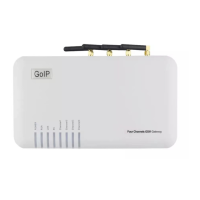GoIP User Manual
http://www.dbltek.com
The device receives SMS messages from both GSM and VoIP networks and they are handled according to the
1. Call Function – In this mode, a received SMS is used to implement the “Call Back” function. The concept is
to establish a phone call between the called party and the calling party. The phone number of the called
party is specified in the GSM SMS message received. The phone number of the calling party is the SMS
sender’s number. The device then sends a SIP INVITE message containing these phone numbers to the
SIP Server registered. Three different SIP INVITE message formats are supported and are described
- The “To” field in the SIP INVITE message contains the phone number of the called party.
- The “From” field contains the phone number of the calling party.
Once the SIP server receives these two numbers via a SIP INVITE message, it then terminates the SIP
call (SIP INVITE) and then call both parties via its own phone network. The device may or may not
take part in the actual call conversation.
SMS content = 8675588228822
Sender’s number = 861380000000
SIP Server IP = 192.168.2.1
The INVITE message sent to the SIP Server is:
INVITE sip:8675588228822@192.168.2.1:5060;transport=udp SIP/2.0
Via: SIP/2.0/UDP 192.168.2.237:5060;branch=z9hG4bK363969813
From: <sip:8613800000000@192.168.2.1:5060>;user=phone;tag=65248630
To: <sip:8675588228822@192.168.2.1>
Call-ID: 117025903@192.168.2.237
Contact: <sip: 8613800000000@192.168.2.237:5060>
Allow: INVITE, ACK, BYE, CANCEL, OPTIONS, NOTIFY, REFER, REGISTER, MESSAGE, INFO, SUBSCRIBE
Content-Type: application/sdp
- The “To” field in the SIP INVITE message contains the phone number of the called party.
- The “From” field contains the SIP number of the line that is associated with the GSM channel
- Note: The VoIP configuration of the device must be set to “Config. By Line mode”.
Only the phone number of the called party is passed to the SIP server via a SIP INVITE message. This
mode is designed to use the GSM channel of the device to complete the Call Back function. Therefore,

